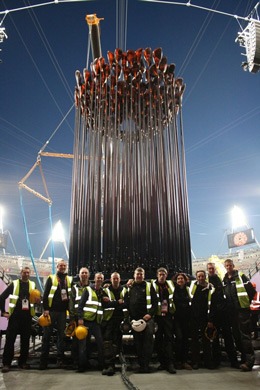The Cauldron, constructed by Stage One in Tockwith, is one of the most enduring and creative symbols of the London 2012 Olympic and Paralympic Games.
204 unique copper elements, each alight and representing every competing nation, were arranged in sublime concentric formation at the tips of slender mechanised steel stems. Slowly pivoting sequentially, they converged to form the Cauldron, in which the Olympic, and later Paralympic flame, would burn brightly for the duration of London’s summer of sport.
The Couldron is to be exhibited in a new gallery at the Museum of London in an exhibition that tells the story of the moment, and celebrates the London 2012 Cauldron.
In the courtyard of the museum, a bespoke new pavilion to house the exhibition has been specially designed and built by Stage One – the creative engineers behind the London 2012 Cauldron. The permanent addition is the first new gallery in the museum since 2010, coinciding with the two year anniversary of the Olympic opening ceremony, when an audience of over one billion people first set eyes on the Cauldron.
The stars of the show are two huge sections of the Cauldron – including the original steel stems and test versions of the copper elements.
Combined they are some of the largest objects the museum has ever acquired. One section presents the Cauldron in an upright position, as it was for the majority of both Games. The other is the Cauldron in an open formation, as if frozen at that climactic defining moment of the opening Olympic ceremony.
Georgina Young, senior curator of contemporary history, said: It is a fitting moment to re-live the collective sense of wonder felt in London and across the globe when the Cauldron was revealed. To be seen in public at the Museum of London, for the first time since the Games, the Cauldron regains the magic of that extraordinary summer.
 Described as “one of the best kept secrets of the opening ceremony”, the gallery immerses visitors in the design and making process of the Cauldron.
Described as “one of the best kept secrets of the opening ceremony”, the gallery immerses visitors in the design and making process of the Cauldron.
Exclusive filmed interviews with Thomas Heatherwick, the artistic directors of the Paralympic opening ceremony, creative engineers from Stage One, and metalworking experts from Contour Autocraft, provide remarkable insight into the rigorous design process, preparation, rehearsal and testing of the Cauldron.
Behind-the-scenes films, footage of the ceremonies and technical drawings add greater context, alongside objects from the production stage – including a selection of the wooden forming blocks on which each copper element was individually crafted.
Thomas Heatherwick said: It’s a huge honour for Heatherwick Studio that the Museum of London have decided to collect and archive the original mechanism of the Cauldron and that a new gallery has been built specifically to exhibit and share it with Londoners and the world. The Cauldron design was kept secret until it was revealed at the opening ceremony, which created an engaging and engrossing experience for many. It’s exciting to reveal the engineering feats that were necessary to make such an extraordinary project happen. The exhibition will give the public the chance to revisit a moment at the heart of London’s most successful sporting event.
Jim Tinsley, Stage One’s technical director, said: Heatherwick Studio’s Cauldron was not just one of the most unusual and complex devices we have ever built – it was also the one that gave us the most pleasure to solve. The whole thing was extraordinary: the chance to work with a creative yet highly precise and logical mind like Thomas’s, on a global hold-your-breath moment that worked so, so beautifully. We might have been tearing our hair out at times, but what a joy, what a privilege.
After the end of the Games, the original copper elements from the Olympic and Paralympic Cauldrons were distributed across the globe to all of the competing nations. The gallery includes a large display of photographs with National Committee representatives, proudly posing with their respective scorched and tarnished petals. The images not only capture fond memories of the London 2012 Games, but also offer a glimpse into each country’s Olympic and Paralympic spirit.
The Olympic and Paralympic Cauldron display is supported by the Department of Culture, Media and Sport. The museum has also launched a fundraising campaign to raise an additional £200,000 to complete this project. To make a donation visit: www.don8.to/MOL001.
To complement the new gallery, there will also be a temporary exhibition of drawings by Nicholas Garland, the artist in residence at the London 2012 Olympic and Paralympic Games. Drawing the Games: London 2012 and Nicholas Garland opens on Friday 25 July until Sunday 28 September.







